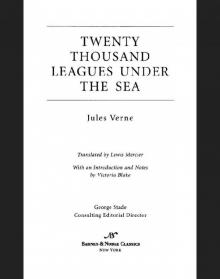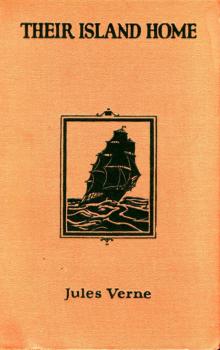- Home
- Jules Verne
A Journey to the Center of the Earth - Jules Verne: Annotated
A Journey to the Center of the Earth - Jules Verne: Annotated Read online
Table of Contents
From the Pages of Journey to the Center of the Earth
Title Page
Copyright Page
Jules Verne
The World of Jules Verne and Journey to the Center of the Earth
Introduction
Acknowledgements
A Note on the Translation
A Note on Measurements
I
II
III
IV
V
VI
VII
VIII
IX
X
XI
XII
XIII
XIV
XV
XVI
XVII
XVIII
XIX
XX
XXI
XXII
XXIII
XXIV
XXV
XXVI
XXVII
XXVIII
XXIX
XXX
XXXI
XXXII
XXXIII
XXXIV
XXXV
XXXVI
XXXVII
XXXVIII
XXXIX
XL
XLI
XLII
XLIII
XLIV
XLV
Endnotes
Inspired by Journey to the Center of the Earth
Comments & Questions
For Further Reading
From the Pages of
Journey to the Center of the Earth
Otto Lidenbrock had no mischief in him, I readily admit that; but unless he changes in unlikely ways, he will die a confirmed original. (page 3)
My uncle went on working, his imagination went off rambling into the ideal world of combinations; he lived far away from earth, and genuinely beyond earthly needs. (page 26)
“All the theories of science demonstrate that such a feat is impossible!” (page 32)
Large though it is, that asylum is not big enough to contain all Professor Lidenbrock’s madness! (page 44)
We traveled around the enormous base of the volcano. The professor hardly took his eyes off it; he gesticulated, he seemed to challenge it and say: “Here’s the giant that I’ll tame!” (page 76)
The crater of Snaefells resembled an inverted cone, whose opening might have been half a league in diameter. Its depth appeared to be about two thousand feet. Imagine the aspect of such a container when it filled with thunder and flames. The bottom of the funnel was about 250 feet in circumference, so that its rather gentle slopes allowed its lower brim to be reached without difficulty. Involuntarily I compared the whole crater to an enormous hollow grenade launcher, and the comparison frightened me. (page 89)
My hair stood on end with terror. The feeling of emptiness overcame me. I felt the center of gravity shifting in me, and vertigo rising up to my brain like drunkenness. There is nothing more treacherous than this attraction toward the abyss. (page 94)
“To Hell with your calculations!” replied my uncle in a fit of rage. “To Hell with your hypotheses!” (page 131)
If the ‘average’ number of difficulties did not increase, we could not fail to reach our goal. And then, what glory! I had come around to reasoning in this way, quite like a Lidenbrock. Seriously. Was this due to the strange environment in which I was living? Perhaps. (page 133)
Impossible to get away. The reptiles approach; they wheel around our little raft at a speed that express trains could not match; they swim concentric circles around it. I’ve gripped my rifle. But what can a bullet do against the scales that cover the bodies of these animals? (page 168)
Ah! the descent of this electric sphere has magnetized all the iron on board; the instruments, the tools, the weapons, move about and clash with a sharp jangle; the nails in my shoes cling tenaciously to a plate of iron set into the wood. I cannot pull my foot away! (pages 180-181)
“As long as the heart beats, as long as the flesh pulsates, I can’t admit that any creature endowed with willpower needs to be overwhelmed by despair.” (page 215)
Ah! What a journey! What a wonderful journey! Having entered through one volcano, we had exited through another, and that other one was more than twelve hundred leagues away from Snaefells, and from that barren landscape of Iceland at the edge of the world! (pages 228-229)
From that day on, the professor was the happiest of scholars, and I was the happiest of men, for my pretty Virland girl, resigning her place as ward, took up position in the house on the Königstrasse in the double capacity of niece and wife. No need to add that her uncle was the illustrious Otto Lidenbrock, corresponding member of all the scientific, geographical, and mineralogical societies on the five continents of the earth. (page 232)
Published by Barnes & Noble Books
122 Fifth Avenue
New York, NY 10011
www.barnesandnoble.com/classics
Le Voyage au centre de la Terre was first published in 1864. Frederick Amadeus
Malleson’s English translation (1877) has been thoroughly revised by
Ursula K. Heise for this edition of Journey to the Center of the Earth.
Published in 2005 by Barnes & Noble Classics with new Biography, Chronology,
Introduction, A Note on the Translation, A Note on Measurements, Notes,
Comments & Questions, and For Further Reading.
Introduction, A Note on the Translation, A Note on Measurements, Notes, and For Further Reading
Copyright © 2005 by Ursula K. Heise.
Translation revisions, Note on Jules Verne, The World of Jules Verne and
Journey to the Center of the Earth, Inspired by Journey to the
Center of the Earth, Comments & Questions, and Illustrations by Rachel Perkins
Copyright © 2005 by Barnes & Noble, Inc.
All rights reserved. No part of this publication may be reproduced or
transmitted in any form or by any means, electronic or mechanical, including
photocopy, recording, or any information storage and retrieval system,
without the prior written permission of the publisher.
Barnes & Noble Classics and the Barnes & Noble Classics
colophon are trademarks of Barnes & Noble, Inc.
Journey to the Center of the Earth
ISBN-10: 1-59308-252-5 ISBN-13: 978-1-59308-252-9
eISBN : 978-1-411-43244-4
LC Control Number 2005923983
Produced and published in conjunction with:
Fine Creative Media, Inc.
322 Eighth Avenue
New York, NY 10001
Michael J. Fine, President and Publisher
Printed in the United States of America
QM
1 3 5 7 9 10 8 6 4 2
Jules Verne
The creator of the roman scientifique, the popular literary genre known today as science fiction, Jules Gabriel Verne was born in the port town of Nantes, France, in 1828. His father, Pierre, was a prominent lawyer, and his mother, Sophie, was from a successful ship-building family. Despite his father’s wish that he pursue law, young Jules was fascinated by the sea and all things foreign and adventurous. Legend holds that at age eleven he ran away from school to work aboard a ship bound for the West Indies but was caught by his father shortly after leaving port.
Jules developed an abiding love of science and language from a young age. He studied geology, Latin, and Greek in secondary school, and frequently visited factories, where he observed the workings of industrial machines. These visits likely inspired his de
sire for scientific plausibility in his writing and perhaps informed his depictions of the submarine Nautilus and the other seemingly fantastical inventions he described.
After completing secondary school, Jules studied law in Paris, as his father had before him. However, during the two years he spent earning his degree, he developed more consuming interests. Through family connections, he entered Parisian literary circles and met many of the distinguished writers of the day. Inspired in particular by novelists Victor Hugo and Alexandre Dumas (father and son), Verne began writing his own works. His poetry, plays, and short fiction achieved moderate success, and in 1852 he became secretary of the Theatre lyrique. dow with two
In 1857 he married Honorine Morel, a young widow with two children. Seeking greater financial security, he took a position as a stockbroker with the Paris firm Eggly and Company. However, he reserved his mornings for writing. Baudelaire’s recently published French translation of the works of Edgar Allan Poe, as well as the days Verne spent researching points of science in the library, inspired him to write a new sort of novel: the roman scientifique. His first such novel, Five Weeks in a Balloon, was an immediate success and earned him a publishing contract with the important editor Pierre-Jules Hetzel.
For the rest of his life, Verne published an average of two novels a year; the fifty-four volumes published during his lifetime, collectively known as Voyages Extraordinaires, include his best-known works, Journey to the Center of the Earth, Around the World in Eighty Days, and Twenty Thousand Leagues Under the Sea.
In 1872 Verne settled in Amiens with his family. During the next several years he traveled extensively on his yachts, visiting such locales as North Africa, Gibraltar, Scotland, and Ireland. In 1886 Verne’s mentally ill nephew shot him in the leg, and the author was lame thereafter. This incident, as well as the tumultuous political climate in Europe, marked a change in Verne’s perspective on science, exploration, and industry. Although not as popular as his early novels, Verne’s later works are in many ways as prescient. Touching on such subjects as the ill effects of the oil industry, the negative influence of missionaries in the South Seas, and the extinction of animal species, they speak to concerns that remain urgent in our own time.
Verne continued writing actively throughout his life, despite failing health, the loss of family members, and financial troubles. At his death in 1905 his desk drawers contained the manuscripts of several new novels. Jules Verne is buried in the Madeleine Cemetery in Amiens.
The World of Jules Verne and Journey to the Center of the Earth
1828 Jules Gabriel Verne is born in the port city of Nantes, France, the first of the five children who will be born to Pierre and Sophie Allotte Verne. His father, an attorney, will encourage young Jules to pursue a career in law. His mother, from a ship-building family, instills in him a love of the sea.
1831 Victor Hugo’s Notre-Dame de Paris (The Hunchback of Notre Dame) is published.
1833 George Sand’s novel Lélia is published by the well-known publisher Pierre-Jules Hetzel, who later will publish Verne’s novels.
1834 Jules begins attending secondary school. During his years at school, he excels in geology, Latin, and Greek. Also greatly interested in machinery, he makes frequent visits to nearby factories.
1839 It is said that the adventurous boy tries to run away to sea aboard a ship bound for the West Indies but is apprehended by his father before reaching open waters.
1843 Tahiti becomes a French protectorate.
1844 Alexandre Dumas’s Le Comte de Monte Cristo (The Count of Monte Cristo) is published.
1847 Jules begins studying law in Paris; he will receive his degree in two years. In Paris, family friends introduce him to some of France’s most distinguished writers, including Victor Hugo. Jules begins writing to supplement his meager allowance . Several of his plays are well received in theaters; his fiction appears in the Parisian magazine Musée des familles.
1852 Louis-Napoleon becomes emperor of France as Napoleon III. Novelists Alexandre Dumas (père and fils) secure Verne a position as secretary of the Theatre lyrique.
1853 French administrator Georges- Eugène Haussmann begins alterations and municipal improvements in Paris, including the construction of the wide boulevards that distinguish the city to this day. The Crimean War begins, pitting Russia against France, England, and the Ottoman Turks.
1854 French poet Charles Baudelaire’s translation of the works of Edgar Allan Poe captivates Verne and initiates his lifelong admiration of the American author.
1857 Verne marries the widow Honorine de Viane Morel, whom he had met the previous year. Quitting his position at the Théâtre lyrique, he embarks on a career as a stockbroker at Eggly and Company, although he continues to devote his mornings to writing. Charles Baudelaire’s volume of poems Les fleurs du mal (The Flowers of Evil) and Gustave Flaubert’s novel Madame Bovary are published.
1859 Verne spends hours in the library gaining the scientific knowledge that will inform his fiction. He travels to England and Scotland. English naturalist Charles Darwin’s On the Origin of Species by Means of Natural Selection is published. Work begins on the Suez Canal.
1861 Verne travels to Norway and Denmark. His son and only child, Michel, is born. He meets the legendary photographer Nadar.
1862 Verne’s manuscript Cinq semaines en ballon (Five Weeks in a Balloon) is accepted by Hetzel for publication. Until his death, Verne will publish an average of two books a year with Hetzel, forming the cumulative series known as Voyages Extraordinaires (Extraordinary Voyages). Hugo’s Les Misérables appears.
1863 Five Weeks in a Balloon is published to great success.
1864 Voyage au centre de la Terre (Journey to the Center of the Earth) is published. Verne writes an article on Poe for Musée des familles.
1865 De la Terre à la Lune (From the Earth to the Moon) appears. English writer Lewis Carroll’s Alice’s Adventures in Wonderland is published.
1866 Voyages et aventures du capitaine Hatteras (The Adventures of Captain Hatteras) is published.
1867 Verne travels with his brother Paul to New York aboard the
1868 Great Eastern. Les enfants du capitaine Grant (The Children of Captain Grant) is published. He purchases his first yacht, the Saint-Michel, named for his only son.
1869 Vingt mille lieues sous les mers (Twenty Thousand Leagues Under the Sea) is published in two volumes (1869-1870). Its depiction of the submarine Nautilus (named after the first submarine, invented around 1800 by American engineer Robert Fulton) predates the construction of the first submarine by twenty-five years.
1870 The Franco-Prussian War breaks out; Verne serves in the Coast Guard.
1871 Une ville flottante (A Floating City), partly inspired by a trip to Niagara Falls, New York, is published. Verne’s father dies. The Franco-Prussian War ends.
1872 The Verne family moves to Amiens, where Verne will reside the rest of his life.
1873 Another Verne masterpiece, Le tour du monde en quatre-vingts jours (Around the World in Eighty Days), is published. French poet Arthur Rimbaud’s confessional autobiography Une Sai- son en Enfer (A Season in Hell) is published.
1874 Le Docteur Ox (Dr. Ox’s Experiment and Other Stories) appears , along with L‘Île mystérieuse (The Mysterious Island). Around the World in Eighty Days is adapted for the stage. Verne purchases a new yacht, the Saint-Michel II.
1875 Le Chancellor (The Chancellor) is published.
1876 Michel Strogoff is published.
1877 Les Indes noires (The Child of the Cavern) and Hector Servadac are published. Verne buys his last yacht, the Saint- Michel III.
1878 A leisurely cruise aboard the Saint-Michel III takes Verne and his brother to North Africa, Portugal, and Gibraltar.
1879 Les Cinq cents millions de la Bégum (The Begum’s Fortune) and Les tribulations d’un Chinois en Chine (The Tribulations of a Chinaman in China) are published.
1880 Verne cruises to Scotland and Ireland. La Maison à vapeur
(The Steam House) is published.
1881 Verne cruises to Holland, Denmark, and Germany. La Jangada (The Giant Raft) is published.
1882 Verne moves his family to a larger house in Amiens with a circular tower; today it is a well-known Verne landmark and the headquarters of the Jules Verne Society in Amiens.
1883 Scottish writer Robert Louis Stevenson’s novel Treasure Island is published. War in Indochina breaks out.
1884 Verne voyages to Italy, where Pope Leo XIII personally blesses his work.
1885 Victor Hugo dies. English novelist Henry Rider Haggard publishes King Solomon’s Mines.
1886 Verne’s deranged nephew, Gaston, shoots him in the leg, laming him for life. This personal disaster, and his growing cynicism about industrialization, marks a turn toward pessimism in Verne’s outlook and writing. His longtime publisher , Hetzel, dies. Verne sells the Saint-Michel III because of financial concerns. Robert Louis Stevenson publishes Dr. Jekyll and Mr. Hyde.
1887 Verne’s mother dies.
1888 Verne is elected to the municipal council of Amiens, where he will serve for fifteen years.
1889 Sans dessus dessous (Topsy-Turvy) appears, which contains notably negative views on the potential of technology. His later novels will take on various forms of social injustice, from the plight of orphans to the corrupting power of missionaries in foreign lands.
1895 English novelist H. G. Wells’s The Time Machine is published .
1897 Le Sphinx des glaces (The Ice Sphinx), written as a sequel to Poe’s 1838 novel The Narrative of Arthur Gordon Pym, is published. Flagging health plagues Verne. His brother Paul dies. English writer Rudyard Kipling’s Captains Courageous and Edmond Rostand’s play Cyrano de Bergerac are published .

 Michael Strogoff; Or the Courier of the Czar: A Literary Classic
Michael Strogoff; Or the Courier of the Czar: A Literary Classic Voyage au centre de la terre. English
Voyage au centre de la terre. English Journey Through the Impossible
Journey Through the Impossible The Castaways of the Flag
The Castaways of the Flag L'île mystérieuse. English
L'île mystérieuse. English Maître du monde. English
Maître du monde. English Around the World in Eighty Days
Around the World in Eighty Days A Voyage in a Balloon
A Voyage in a Balloon From the Earth to the Moon, Direct in Ninety-Seven Hours and Twenty Minutes: and a Trip Round It
From the Earth to the Moon, Direct in Ninety-Seven Hours and Twenty Minutes: and a Trip Round It Paris in the Twentieth Century
Paris in the Twentieth Century City in the Sahara - Barsac Mission 02
City in the Sahara - Barsac Mission 02 The English at the North Pole
The English at the North Pole The Field of Ice
The Field of Ice From the Earth to the Moon
From the Earth to the Moon Un capitaine de quinze ans. English
Un capitaine de quinze ans. English The Mysterious Island
The Mysterious Island Les indes-noirs. English
Les indes-noirs. English Robur-le-conquerant. English
Robur-le-conquerant. English Propeller Island
Propeller Island Around the World in Eighty Days. Junior Deluxe Edition
Around the World in Eighty Days. Junior Deluxe Edition Les forceurs de blocus. English
Les forceurs de blocus. English In the Year 2889
In the Year 2889 Journey to the Centre of the Earth
Journey to the Centre of the Earth Twenty Thousand Leagues Under the Sea
Twenty Thousand Leagues Under the Sea From the Earth to the Moon; and, Round the Moon
From the Earth to the Moon; and, Round the Moon Vingt mille lieues sous les mers. English
Vingt mille lieues sous les mers. English Cinq semaines en ballon. English
Cinq semaines en ballon. English Twenty Thousand Leagues under the Seas
Twenty Thousand Leagues under the Seas Face au drapeau. English
Face au drapeau. English Michael Strogoff; Or, The Courier of the Czar
Michael Strogoff; Or, The Courier of the Czar Un billet de loterie. English
Un billet de loterie. English The Secret of the Island
The Secret of the Island Off on a Comet! a Journey through Planetary Space
Off on a Comet! a Journey through Planetary Space Into the Niger Bend: Barsac Mission, Part 1
Into the Niger Bend: Barsac Mission, Part 1 All Around the Moon
All Around the Moon A Journey to the Center of the Earth - Jules Verne: Annotated
A Journey to the Center of the Earth - Jules Verne: Annotated 20000 Lieues sous les mers Part 2
20000 Lieues sous les mers Part 2 Robur-le-Conquerant
Robur-le-Conquerant Les Index Noires
Les Index Noires Michael Strogoff; or the Courier of the Czar
Michael Strogoff; or the Courier of the Czar 20000 Lieues sous les mers Part 1
20000 Lieues sous les mers Part 1 Twenty Thousand Leagues Under the Sea (Barnes & Noble Classics Series)
Twenty Thousand Leagues Under the Sea (Barnes & Noble Classics Series) Five Weeks In A Balloon
Five Weeks In A Balloon Journey to the Center of the Earth
Journey to the Center of the Earth 20,000 Leagues Under the Sea
20,000 Leagues Under the Sea Journey to the Center of the Earth (Barnes & Noble Classics Series)
Journey to the Center of the Earth (Barnes & Noble Classics Series) Adrift in the Pacific-Two Years Holiday
Adrift in the Pacific-Two Years Holiday The Collected Works of Jules Verne: 36 Novels and Short Stories (Unexpurgated Edition) (Halcyon Classics)
The Collected Works of Jules Verne: 36 Novels and Short Stories (Unexpurgated Edition) (Halcyon Classics) The Survivors of the Chancellor
The Survivors of the Chancellor Their Island Home
Their Island Home Le Chateau des Carpathes
Le Chateau des Carpathes Les Cinq Cents Millions de la Begum
Les Cinq Cents Millions de la Begum The Floating Island
The Floating Island Cinq Semaines En Ballon
Cinq Semaines En Ballon Autour de la Lune
Autour de la Lune